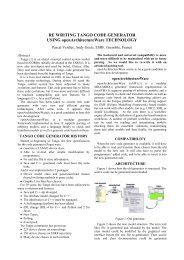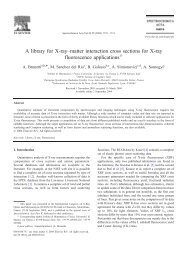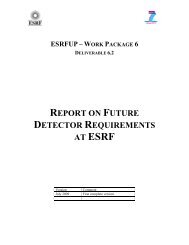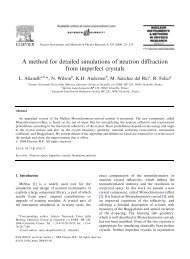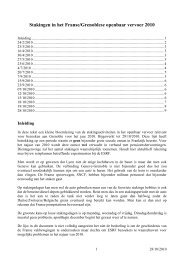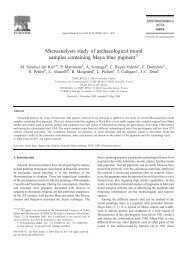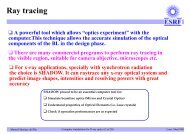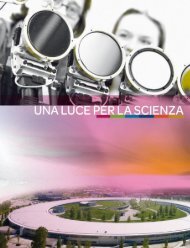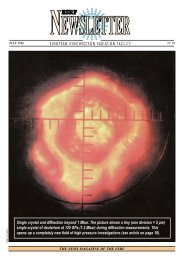New Scientific Opportunities at the European Synchrotron Radiation ...
New Scientific Opportunities at the European Synchrotron Radiation ...
New Scientific Opportunities at the European Synchrotron Radiation ...
Create successful ePaper yourself
Turn your PDF publications into a flip-book with our unique Google optimized e-Paper software.
<strong>European</strong> <strong>Synchrotron</strong> Radi<strong>at</strong>ion Facility Long-Term Str<strong>at</strong>egy 7 July 2006<br />
• Development of a surface finishing device (Ion Beam Figuring) coupled to in situ<br />
X-ray metrology. This technology will allow <strong>the</strong> correction of optical surfaces with<br />
figure errors below <strong>the</strong> µrad level and is <strong>the</strong>refore mand<strong>at</strong>ory for nano-focusing KB<br />
optics. The feasibility of this concept has been demonstr<strong>at</strong>ed by <strong>the</strong> prototype<br />
machine under development.<br />
• Development of coherence preserving optics oper<strong>at</strong>ing under high he<strong>at</strong> load and<br />
radi<strong>at</strong>ion impact of <strong>the</strong> white beam. Both crystal and multilayer based optical<br />
elements and rel<strong>at</strong>ed cooling schemes have to be optimised to maintain <strong>the</strong> wave<br />
front quality. Diamond crystals will play an essential role for <strong>the</strong>se applic<strong>at</strong>ions.<br />
Their improvement will have to be pushed in collabor<strong>at</strong>ion with industrial partners.<br />
This project requires access to a dedic<strong>at</strong>ed insertion device test beamline.<br />
• Collabor<strong>at</strong>ive development and fabric<strong>at</strong>ion of transmission optics (compound<br />
refractive lenses, Fresnel zone pl<strong>at</strong>es, waveguides, etc.). So far, <strong>the</strong>se devices<br />
were purchased or obtained through individual collabor<strong>at</strong>ions with external<br />
institutes. Direct access to <strong>the</strong> development of such elements could be made by<br />
<strong>the</strong> install<strong>at</strong>ion of a dedic<strong>at</strong>ed facility as an integral part of a <strong>European</strong> Nano-<br />
Science Centre.<br />
• Development of <strong>the</strong>oretical tools describing diffraction limited X-ray optical<br />
systems. Theories and codes based on wave propag<strong>at</strong>ion will be necessary to<br />
provide <strong>the</strong> basis for design and fabric<strong>at</strong>ion.<br />
• Development and upgrade of metrology tools. These are essential to analyse <strong>the</strong><br />
results of <strong>the</strong> fabric<strong>at</strong>ion processes and to improve <strong>the</strong>m, to study <strong>the</strong> influence of<br />
mounting and bending crystals, mirrors and multilayers, to position optical<br />
elements in <strong>the</strong> beam and to detect vibr<strong>at</strong>ions and/or <strong>the</strong>rmal degrad<strong>at</strong>ions. Ex situ<br />
evalu<strong>at</strong>ions will use upgraded instruments in <strong>the</strong> ESRF optical metrology<br />
labor<strong>at</strong>ory. In situ studies will be carried out <strong>at</strong> <strong>the</strong> Optics Beamline BM05<br />
whenever possible, o<strong>the</strong>rwise, according to present plans, using <strong>the</strong> undul<strong>at</strong>or<br />
source beamtime th<strong>at</strong> will become available on ID06 for optics tests.<br />
It has to be stressed th<strong>at</strong> <strong>the</strong> above items are strongly interlinked. The overall budget<br />
envelope is difficult to estim<strong>at</strong>e since part of <strong>the</strong> projects will crucially depend on <strong>the</strong><br />
active particip<strong>at</strong>ion of external <strong>European</strong> partners.<br />
4.4.3 Nano-manipul<strong>at</strong>ion<br />
The characteris<strong>at</strong>ion of samples <strong>at</strong> <strong>the</strong> nanometre scale will play a central role in<br />
science, raising new problems and new challenges. One of <strong>the</strong> major difficulties to be<br />
overcome will be <strong>the</strong> recognition and handling of <strong>the</strong> samples and <strong>the</strong>ir manipul<strong>at</strong>ion<br />
and modific<strong>at</strong>ion in real time. These problems are <strong>at</strong> <strong>the</strong> limits of optical microscopy,<br />
while electron microscopy can electrically charge <strong>the</strong> samples. Pre-alignment could<br />
become a very cumbersome oper<strong>at</strong>ion, while <strong>the</strong> analysis of free standing samples<br />
will be hindered by <strong>the</strong> electrical charging problems induced by <strong>the</strong> X-rays. It is<br />
necessary, <strong>the</strong>refore, to envisage a new approach to manipul<strong>at</strong>ion and oper<strong>at</strong>ion <strong>at</strong><br />
<strong>the</strong> nano-scale. Scanning Probe Microscopes (SPM) are extensively used in nanotechnology<br />
to see and manipul<strong>at</strong>e samples of nanometric size, but <strong>the</strong>ir applic<strong>at</strong>ion in<br />
real time under X-ray beams is just beginning. Never<strong>the</strong>less <strong>the</strong> reduced size of<br />
SPMs and <strong>the</strong>ir limited cost makes <strong>the</strong>m ideal for use on SR beamlines, providing<br />
new tools for visualising, positioning and manipul<strong>at</strong>ing nano-samples.<br />
26



